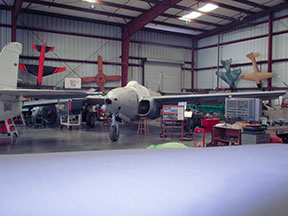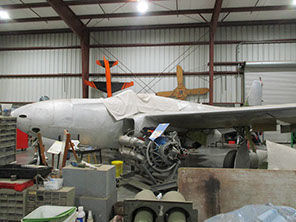Serial Number# 42-108777 Manufacturers Construction# 27-10
Bell Aircraft Corp. YP-59A


Bell Aircraft Corp. YP-59A 42-108777 was built at their Buffalo, New York factory and was seventh out of thirteen YP-59As completed. It is the only surviving YP-59A extant. An exact date of completion of the aircraft at the Bell factory is currently unknown but it is believed it could have been as early as November 16, 1943. 42-108777 was the first YP-59A to be fitted with the more powerful General Electric I-16 engines and complete performance tests with these engines were completed by April 1944. The I-16 is the General Electric J-31-GE-3 of 1650 lbs. thrust each, a slight improvement over the original engines. As completed, 42-108777, was one of the first nine P-59s, and was fitted with two 37 mm M-4 cannon. In order to improve roll performance, she received
a squared off vertical stabilizer and rudder. As a result of these modifications the wingspan was reduced from 49 feet to 45 feet six inches and overall height was reduced from 12 feet 4 inches to 12 feet.
After tests with the new engines were completed, 42-108777 was disassembled and shipped by rail across the country to Muroc Army Air Force Base in California’s Mojave Desert. Muroc AAF base as it was then known, was a Flight Test Center, and had been chosen as the location for the tests due to its secluded location away from prying eyes in the Mojave Desert. At Muroc AAF base, 42-108777 was reassembled and flight testing for the Army Air Force began. The aircraft was delivered to the AAF and accepted for service on May 19, 1944 with the 4144th Air Base Unit, part of the 412th Fighter Group. It was here that initial AAF flight testing was conducted between May and September of 1944.
September 1944 saw 42-108777 transferred to Palmdale AAF base which was a satellite base for Muroc AAF base. It was here that she was assigned to the 445th Fighter Squadron of the 412th Fighter Group. The 412th FG was to be the first all jet Fighter Group of the United States Army Air Force. It was composed of three squadrons; The 29th FS known as the “Gamecocks”, the 31st FS known as the “Foxes” and the 445th FS. The mission of the 412th FG was to conduct flight training for pilots that were transitioning from piston engine aircraft to the new jets. This unit trained ground crews in the intricacies of working on jet engines and aircraft and also to devise new jet fighter tactics.
In October 1944, 42-108777 was briefly transferred to San Bernardino AAF base before being shipped across country to Patuxent River Naval Air Test Center in Maryland to attend the Fighter Conference. Held between 16 and 23 October 1944, 42-108777 was the only jet aircraft in attendance and was amongst a selected group of in service fighter aircraft and prototypes that was there to be tested against foreign aircraft including the Mitsubishi A6M5 Zero that is currently owned by the Planes of Fame Air Museum. It is also known that 42-108777 was the first jet aircraft that renowned Grumman test pilot Corwin “Corky” Meyers had ever flown. At the conclusion of the Fighter Conference, 42-108777 returned to Palmdale AAF base at the end of October 1944 and very shortly afterward on October 27,1944, the 445th FS was transferred to Bakersfield AAF base.
The 445th FS remained at Bakersfield AAF base for the remainder of 1944 and into January 1945 and continued to train pilots and ground crews in jet operations while the 445th FS was slowly brought up to full strength. On January 12, 1945, 42-108777 was transferred to San Bernardino AAF base and became part of the 4126thAAF Base Unit. It remained there until transferring again briefly to Thermal AAF base on March 10, 1945.
On March 14 1945, 42-108777 returned to Bakersfield AAF base and the 445th FS however the time at Bakersfield AAF base marked the beginning of the end of the service life for the P-59. November 1944 saw the 412th FG receive the first of the Lockheed XP-80 Shooting Star jet fighters which in due course would replace the P-59 series aircraft in the 412th FG. Between May 3, 1945 and May 29, 1945, 42-108777 deployed to Lemoore AAF base before returning to Bakersfield. On April 23, 1945 all XP-59 and YP-59As were to be removed from service. A letter of Termination was posted from the Aircraft Projects Section at Wright Field to Bell Aircraft Corp. formally ending the P-59 program. This was due to the fact that the superior Lockheed XP-80 Shooting Star would soon replace all P-59s in non-combat service.
Upon returning to Bakersfield, 42 108777 was one of four P-59s that was having survey and reclamation work carried out. Army Air Force equipment such as armament, gun sights etc. was being removed from aircraft that would be ending their service lives with the AAF in the near future.
Following survey and reclamation work that was carried out at Bakersfield AAF base, on June 16,1945 42-108777 was transferred to Palmdale AAF base for final service with the 31st FS “Foxes”, also part of the 412th FG and remained there until July 10,1945. It was then transferred to Santa Maria AAF base and 42-108777 would remain there until November 14, 1945.
At some point in its history, 42-108777 had been modified with a small second cockpit in the nose of the aircraft and had been fitted with a small custom made canopy. The second cockpit had been installed in order to accommodate rides for VIPs. As far as is known by this author, 42-108777 was never involved in the drone program. According to the best information available, the Drone/Robot program had been completed in late 1944and early 1945 by Bell and Sperry before 42-108777 was accepted by the USAAF. During the course of its restoration at the Planes of Fame Air Museum which began in 1991, the front cockpit was removed and 42-108777 was returned to its original configuration.
November 14, 1945 42-108777 arrived at March AAF base assigned to the 420th Base Unit. March AAF Bases’ primary mission was as a heavy bomber training facility and it would seem odd that a jet fighter would be assigned to this location however it is likely that it was simply being stored there pending its final disposition. The AAF eventually declared 42-108777 as “airworthy but excess to its needs”. On June 26, 1946 the USAAF disposed of 42-108777 by placing the aircraft as “On loan to the US Navy” for use as an instructional airframe. On February 13, 1947 the aircraft was finally dropped from the USAAF inventory and it was sent to the San Luis Obispo Naval School.
42-108777 spent the next eleven years as an instructional aide at the San Luis Obispo Naval School and at California Polytechnic College at San Luis Obispo before being acquired by Ed Maloney in March 1958 for his burgeoning The Air Museum based at Claremont, California. As time went on, The Air Museum grew and moved to Ontario International Airport in Ontario, California, and finally to its present location at Chino Airport in Chino, California. The YP-59A remained on display as an important display of Americas’ first tentative step into the jet age.
In 1991, a major change in fortunes occurred for 42-108777. The decision had been made to not only restore the historic aircraft but to restore it to airworthy condition. Steady progress has been made over the years with three engines being overhauled and the entire airframe being inspected and restored by a dedicated group of volunteers and outside contractors donating their time and materials. In the future we can look forward to the first flight of this beautifully restored aircraft and when this event occurs, 42-108777 will become the oldest operational jet aircraft in the world. This aircraft and its ongoing restoration may be seen at the Planes of Fame Air Museum’s Restoration hangar in Chino, California.
By Kenneth Keller
